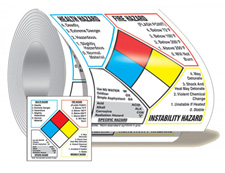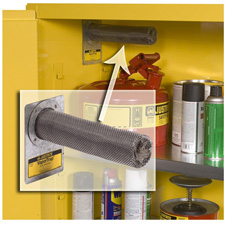



Find all of your laboratory and workplace safety supplies at Safety Emporium!
 Viscosity |
 Glossary Index |
 Volatility |
| MSDS Topics |
Free Sites | FAQ's | Regulations | Glossary | Software | Suppliers |
| Books | Forum | Poll | Fun stuff | Quiz | Store | |
| Understand your MSDS with the MS-Demystifier | Search ALL our MSDS info | |||||

Communicate workplace hazards with handy labels from Safety Emporium.
Volatile Organic Compounds (VOC's) are organic chemicals that have a high vapor pressure and easily form vapors at normal temperature and pressure.
The term is generally applied to organic solvents, certain paint additives, aerosol spray can propellants, fuels (such as gasoline, and kerosene), petroleum distillates, dry cleaning products and many other industrial and consumer products ranging from office supplies to building materials. VOC's are also naturally emitted by a number of plants and trees.
TVOC stands for Total VOC's and is the concentration of all VOC's in a given sample (there may be several different VOC's present in a sample).
A VOC number, VOC rating, or VOC content expresses the amount of volatile material in a sample, either in pounds per gallon, grams per liter or as a percentage by mass.

Keep your workplace safe by using the VaporTrap™ Filter for VOC Vapors from Safety Emporium.
VOC's are an important health and environmental concern for several reasons:
VOC's can be removed from air or water using special filtration systems. For example, activated charcoal absorbs many organic materials, but it has a limited capacity, is not an indicating adsorbent (so you won't know when it has reached its limit) and does not adsorb all materials.
Minimize or eliminate the use of VOC's whenever possible (see item #2 under Further Reading below). If you must use a VOC, minimize your exposure by using proper engineering controls such as a fume hood or other form of local exhaust ventilation. Gloves, a respirator and/or other appropriate personal protective equipment may also be necessary if the hazard can not otherwise be reduced to acceptable levels.
Whenever using a flammable material use adequate ventilation and remember that vapors may travel large distances. Heavier-than-air vapors (as most organic vapors are) can "pool" in low-lying areas, leading to an explosion when ignited by a flame, spark or static electricity. There are several reports each year of people blowing up their basements and themselves when using floor sealers etc. in a basement where the furnace or hot water heater pilot light ignited VOC's that had reached their lower explosive limit.
NOTE: We may collect a share of sales or other compensation from the links in the following list:

Breathe easy with respirators and accessories from Safety Emporium.
See also: engineering controls, flash point, flammable limits, fume hood, NFPA, ventilation.
Additional definitions from Google and OneLook.
Entry last updated: Thursday, August 11, 2022. This page is copyright 2000-2025 by ILPI. Unauthorized duplication or posting on other web sites is expressly prohibited. Send suggestions, comments, and new entry desires (include the URL if applicable) to us by email.
Disclaimer: The information contained herein is believed to be true and accurate, however ILPI makes no guarantees concerning the veracity of any statement. Use of any information on this page is at the reader's own risk. ILPI strongly encourages the reader to consult the appropriate local, state and federal agencies concerning the matters discussed herein.